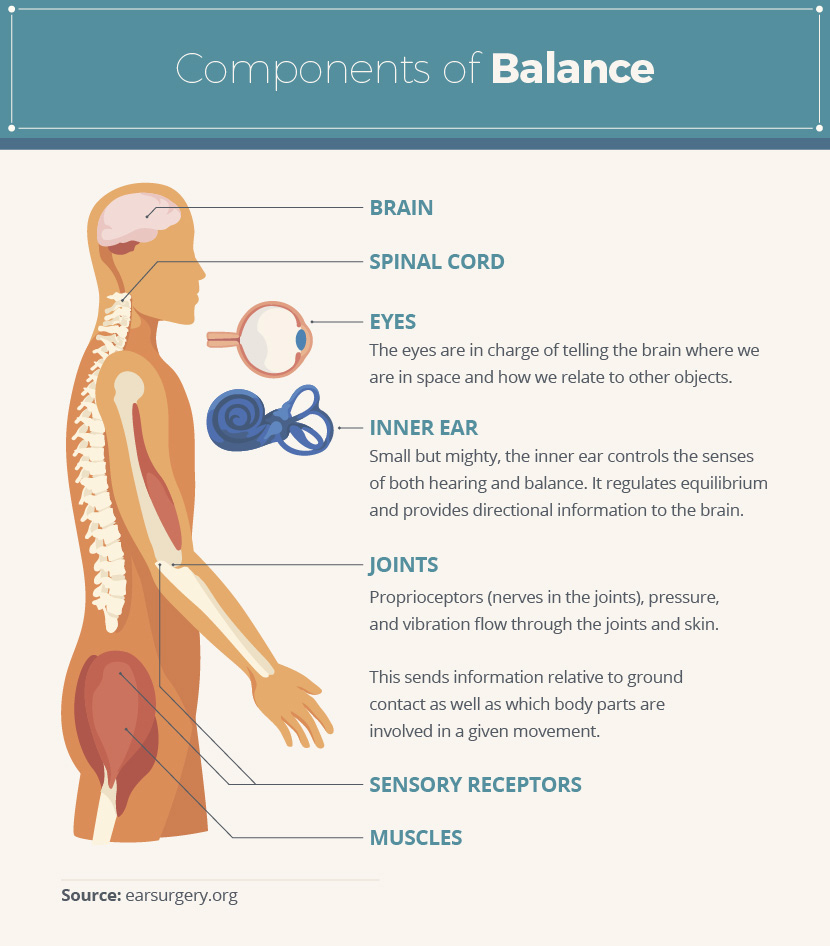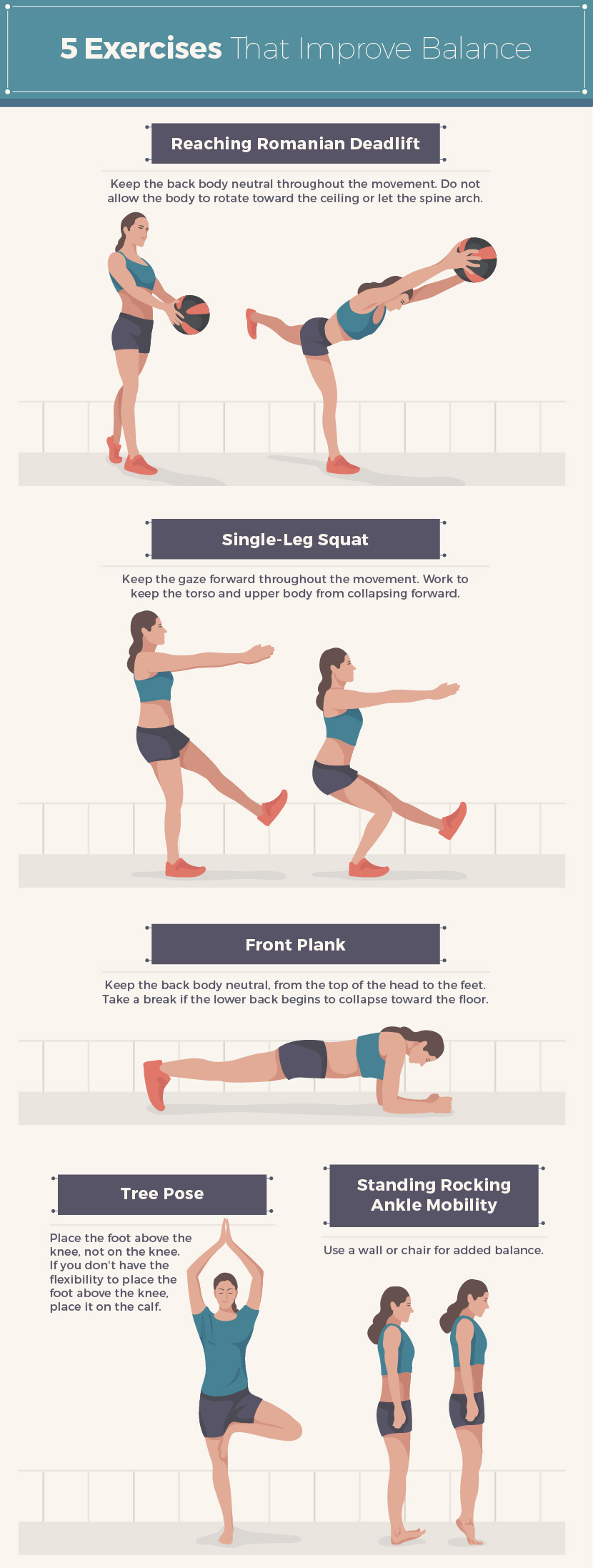
Get your fix of expert articles delivered straight to your inbox!
No Thanks - I don't like cool stuff

Balance and strength go hand in hand when improving overall function. Exercises that build strength can also help improve balance, which is crucial as we age. Young, healthy individuals generally balance reflexively, but for older adults, daily balance work helps keep the body primed and ready to move through any environment.
To put it simply, balance is the ability to move without falling. It is what keeps us upright when walking and helps us stay on a bicycle when riding. Information is sent from the inner ear, other senses, and the skeletal muscular system so the brain understands how the body is positioned within a given environment. More specifically, the inner ear, eyes, skin, muscle, and joint receptors all work together to send pieces of information to the central nervous system regarding motion, space, ground contact, and which body parts are involved in movement.http://www.medicinenet.com/script/main/art.asp?articlekey=10760

Daily exercise keeps the body strong, which translates to better balance. A simple 15-minute brisk walk every evening can maintain balance as we age. However, weekly strength activities are key to moving smoothly and helping to prevent bumps and bruises due to teetering off balance.
Plenty of activities, including biking, swimming, climbing, yoga, and tennis, help improve coordination and balance over time. We also recommend adding daily balance exercises (like the ones below) to increase and maintain balance and mobility.

This exercise works best while holding a medicine ball, but a single dumbbell held horizontally in both hands works as well. Bearing your weight on the right leg, hold the medicine ball in both hands in front of your legs. Bend the right knee slightly, hinging at the hips. Raise the left leg behind you and the arms in front, creating a straight line from the medicine ball to the left foot. At the full range of the motion, the body should be aligned perpendicular to the right leg. Slowly return to the starting position. Repeat for 10 reps on the right side, and then switch to the left leg.
Building muscles unilaterally (on one side) helps balance weaknesses. Stand with your arms reaching out in front of your torso, bearing your weight on the right leg. Extend the left leg so it is elevated from the ground. Squat down by bending at the knee and hip simultaneously, keeping the knee aligned with the toe. Lower yourself as far as possible and then press back up to the starting position. Repeat for 5 to 10 reps on the right side before switching to the left side.
The key to good balance lies in a strong core. Lay belly side down with the elbows pressed to the floor. Press up so the torso and legs move off the floor. Tilt the pelvis forward so the hips align with the ribs, engaging the abdomen and glutes. Squeeze the thighs and keep the head aligned with the torso. Hold for 10 to 30 seconds. Repeat three times.
This classic yoga pose is great for balance. Bear all your weight on the right foot. Bend the left knee, grabbing the left foot to bring it to the right inner thigh. Press the foot into the thigh with the toes pointed toward the floor (try not to push into the knee joint). If making contact with the inner thigh is out of your range of motion, press the foot into the opposite calf muscle. Raise the hands above the head, reaching toward the ceiling while pressing the right foot firmly into the floor. Hold this pose for 30 to 60 seconds. Release and repeat on the other side.
Though simple, this move can get tricky. It is a good idea to hold onto a support on the first try. While standing, rock slowly back onto the heels, raising the toes off the floor. Then rock forward onto the toes, raising the feet off the floor. Repeat 10 times.
Balance work is not limited to exercise. Daily activities and practice can tap into the senses and systems that communicate balance to the brain.

Let us start with the system involved in equilibrium. Different parts of the inner ear can detect movement from front to back and side to side, as well as rotational movements. Subjecting these inner ear apparatuses to quick movements that change equilibrium is one way to train for balance. Another option is to take better care of your ears.
Keep the volume at a healthy level when listening to music or watching television. This is especially important when using headphones or ear buds. Noise measured higher than 85 decibels (dB) can damage hearing, which can lead to balance issues as you age. Exposure to loud noises such as fireworks can affect hearing, but long-term exposure to higher decibels is the primary cause for concern. The higher the decibel, the shorter the amount of time it takes to deteriorate hearing – and in turn, balance.http://www.osteopathic.org/osteopathic-health/about-your-health/health-conditions-library/general-health/Pages/headphone-safety.aspx
Most music devices, including iPods and other MP3 players, have a volume control that adjusts up to 120 dB. Just 10 minutes at that level can cause gradual, cumulative hearing loss. A good rule of thumb is to keep the headphone volume below 60 percent of the maximum for a given device.
Cushiony, expensive running and walking shoes have a built-in balance system that defies what the body can do naturally. Kick off your shoes as much as possible and allow your feet to make contact with the ground. This helps the nerve receptors in the foot talk to the brain about how your body is interacting with the environment. A good practice is to spend some time each day on different surfaces like carpet, hard flooring, grass, gravel, and even pillows or thick mats without shoes on.
If you tend to experience foot pain when walking without shoes, ease into this practice by standing on different surfaces for short periods of time. You can gradually build up to walking for longer durations. Foot pain may be caused from years of wearing ill-fitting shoes, so it takes time to ease into going barefoot. More than 20 muscles in the foot propel the body forward.https://barefoot-science.com/cause/ These muscles are denied activation when continually molded into shoes. A little more time barefoot each day can help rebuild those muscles and reduce pain over time.
When out and about during your day, pay attention to your environment and make use of alternative objects and paths. Try walking along curbs, tromping through gravel paths, and following a narrow ridge with your bike. The more you challenge your body to balance on different surfaces, the better your balance may become.
Your ears, eyes, joint receptors, and brain all work in conjunction to maintain balance day in and day out. As we age, it is increasingly important to practice daily balancing acts to help avoid mobility deterioration, which can lead to a potential fall. Quick practices, such as standing on one leg while brushing your teeth or taking a few steps with your eyes closed, can lead to better daily balance.

Get your fix of expert articles delivered straight to your inbox!
No Thanks - I don't like cool stuff